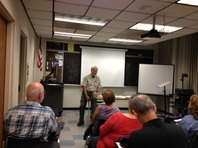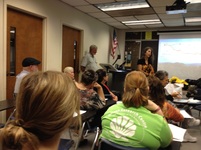|
We are considering offering our Community Education class, Hiking the Camino in Spain, as a one-day immersion mini-workshop on a weekend in February or March. The Saturday class, from 9:00 to 5:00, would cover all the why, when, what, where, and HOW questions of preparing for a Camino hike. Sunday would be a long training hike at San Felasco Hammock. We would cover about 6 miles, have a break for lunch and rest, and then a second 6-miler on a different trail. Folks could do either or both segments. Does this idea sound appealing to Camino Dreamers?
2 Comments
Whenever we meet friends and acquaintances, we are inevitably asked about our walking plans for 2014. The honest answer has always been the same: we haven't decided.
We have been looking into several possibilities, however. One option would be to walk the entire Camino Frances from Saint Jean Pied de Port to Muxia in one inning, as some of our friends and former students have done. That would be a worthy challenge, but has some downsides, including the likely wear and tear on our bodies, and the fact that we would be covering old ground, some of which we have already covered three times. So we're considering the Camino Portugues, parts of the Chemin de Arles, and the Via Francigena (the Florence to Rome section). Any advice or recommendations will be welcome. A Class in the Spring of 2014? We're thinking about possibly offering a Camino course through Santa Fe College in the Spring of 2014. One idea would be to condense four sessions (expanded from 2013) into two weekend days. Another idea would be to include a field trip to demonstrate hiking gear and its use.
We'll be looking forward to any comments or suggestions. |
Archives
July 2022
AuthorsPeg and Russ Hall Categories
All
|
- Home
- Blog
- Second Wind
- Maps
- Why Walk It?
-
Practicalities
- Step 1. Planning Your Camino -- What kind, Where, When, How far, Alone, Getting there . . .
- Step 2. Getting Ready -- Training, Packing, Gear, Clothes, Electronics, Passports, TSA . . .
- Step 3. Being There -- Money, Lodgings, Food, Language . . .
- Step 4. Adapting -- Guidebooks, Websites, Trail conditions, Schedule, Water, Weather, Pain, Hazards, Phones . . .
- Step 5. Being a Pilgrim and a Tourist -- Types of pilgrimmage, Roman roads, Medieval life, Wonders . . .
- Step 6. Living the Lessons of the Camino -- Once or again, Connecting at home, Being hospitaleros . . .
- Who Are We?
- All Our Caminos


 RSS Feed
RSS Feed